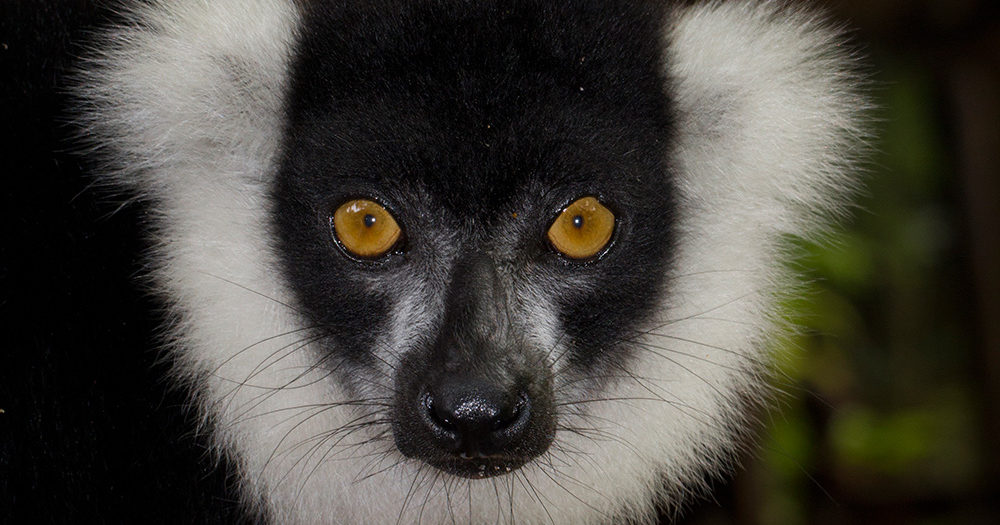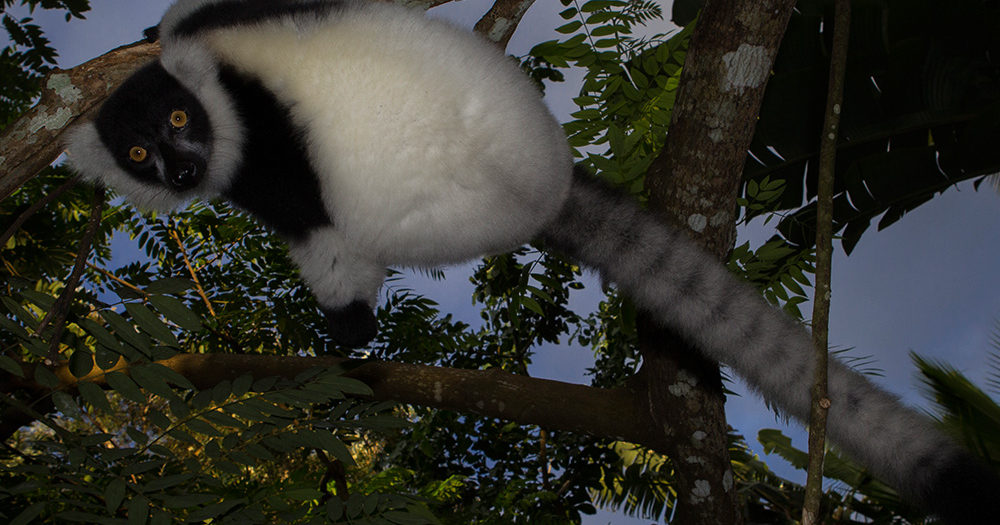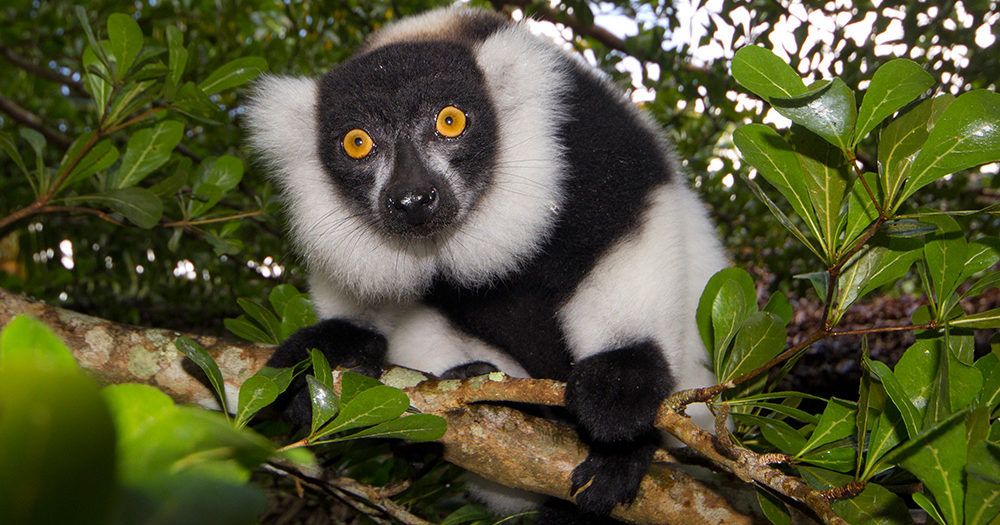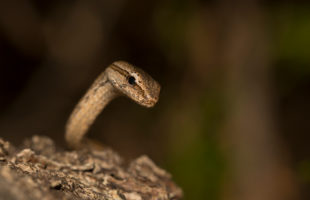Many people know them from zoos and animal parks: Black-and-white ruffed lemurs (Varecia variegata). Besides Red Ruffed Lemurs and the Indri, they belong to the largest lemurs with a head-torso length of 40 to 60 cm, an additional 60 cm added for the tail. Weights of 3 to 4 kg are the average. Black-and-white ruffed lemurs exclusively live in the small, residual rainforest stripe along the east coast. Sadly, the left habitats are extremely scattered and isolated from each other, so the populations do not mix anymore.
In 2001, the black-and-white ruffed lemur was lifted to species status. Today three subspecies are known. The northern black-and-white ruffed lemur (Varecia variegata subcincta) lives in northeast Madagascar and occurs in Nosy Mangabe special reserve, in Makira massif and in Mananara-Nord national park. Somewhat more south lives the variegated black-and-white ruffed lemur (Varecia variegata variegata), which is most common to travellers. It inhabits the area around Ambatovaky, Betampona and Zahamena national park. The subspecies that occurs southernmost is the southern black-and-white ruffed lemur (Varecia variegata editorum). It inhabits the area of Andasibe-Mantadia national park, Ranomafana national park and Manombo special reserve. Accordingly, the black-and-white fur pattern varies depending on subspecies and regions. Simply said: The more south a ruffed lemur lives, the more white is his fur. But there are many pattern variations among the different populations, with flowing transitions.
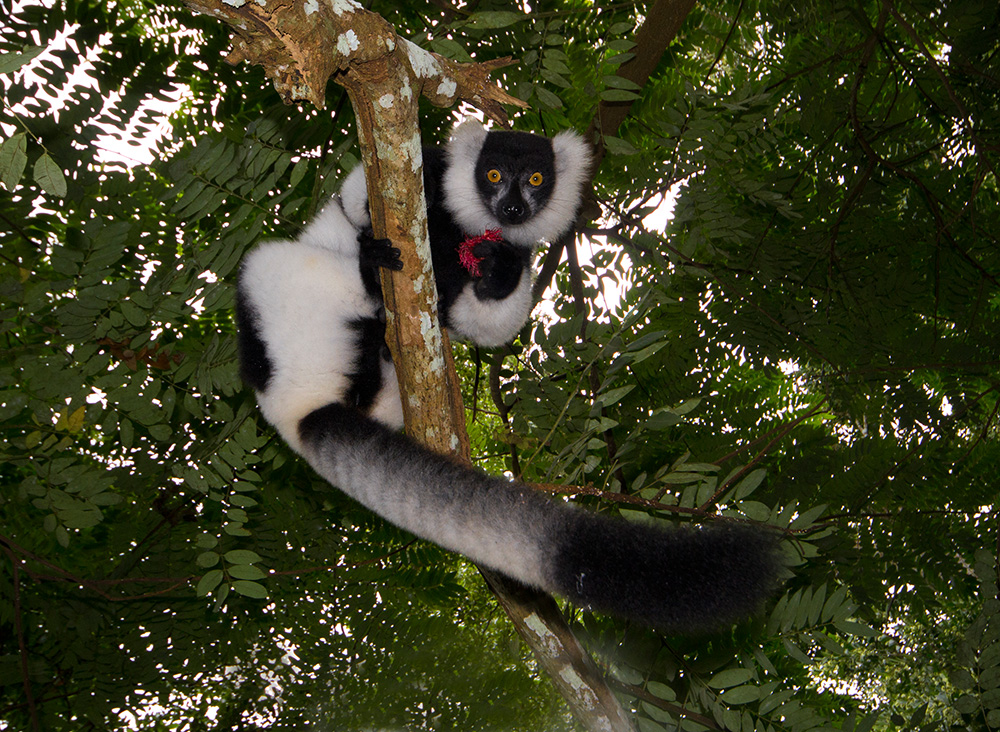
Ruffed lemurs spend all their life up in the trees. Only very rarely do they touch the ground. Even to reach edible stuff right above the earth, they prefer to hang upside down from a tree instead of jumping down. On branches, they move on all fours but are able to jump a few meters. Most black-and-white ruffed lemurs live in small family groups, but sometimes they even join larger, mixed groups of up to 16 individuals. Among the group, the females rule the roost: They decide where the group rests and where not, and generally may take the best places for food. Males lose a little out.
For all black-and-white ruffed lemurs, the day begins in their sleeping nest. In the early morning, the group begins to forage for food: Tasty fruits, flowers and leaves. The group is always led by the senior female. And these lemurs are real gourmets: Among all lemurs, fruits make the largest parts of their diet with more than three-thirds of all food being fruits. The sweet nectar is another special favourite dish of ruffed lemurs. While licking the sweet juice, they invisibly carry pollen from plant to plant, thus pollinating for example the travelers’ tree. More than 130 different plants are part of a black-and-white ruffed lemur’s diet, among them Bureracea and laurel plants (Cryptocarya, Ocotea), Grewia, mulberry (Moraceae) and myrtle plants (Myrtaceae). Around noon, when temperatures reach their peak, the ruffed lemurs take a rest and look for a nice place in the trees to doze a little – actually, they spend more than half of the day resting. It is not before the late afternoon that they use the left time until sunset to forage again. As soon as twilight falls, the ruffed lemurs seek out their sleeping places, preferably high up in broad, protruding trees crowns.
Black-and-white ruffed lemurs become sexually mature at an age of two or three years. Each group usually has one breeding couple producing offspring. Only in larger groups, do females mate with several males. Mating takes place during the dry season, in June or July. In contrast to other very rare lemurs, black-and-white ruffed lemurs are not receptive only one single time in the year, but once a month for about one week – which is, of course, much more practical for reproduction.
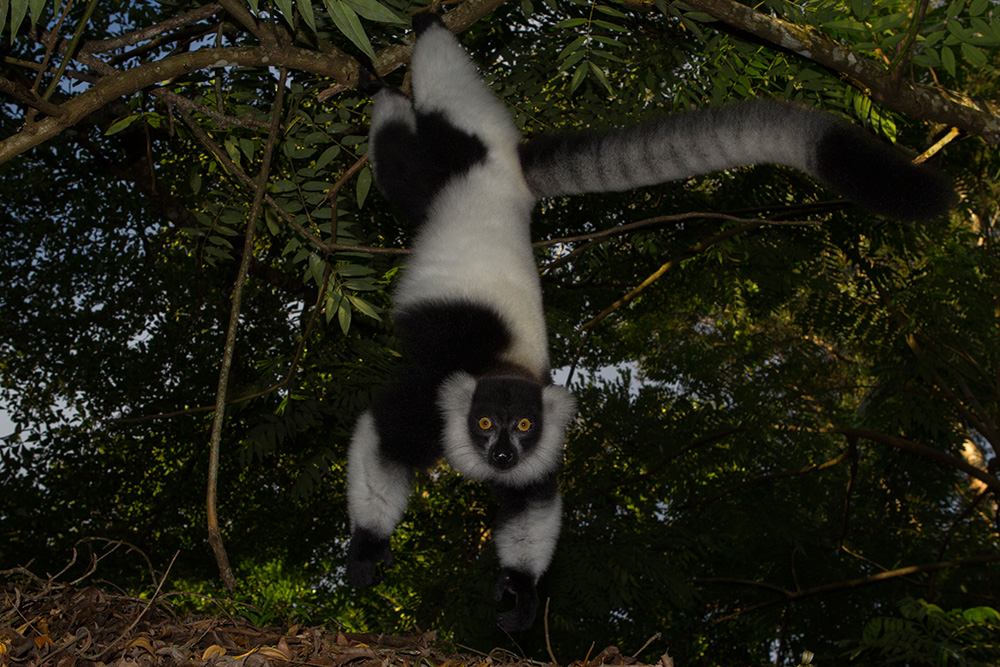
After no more than three months, the female bears two or three young in a birth nest high up in the trees. It is the beginning of the rainy season now, around October. The birth nest is used only a few days, then the young mother moves with her offspring to a new one. In rare cases, she may get quadruplets or sextuplets. Single offspring is very rare, which is the opposite of many other lemur species. In contrast to ring-tailed lemurs, Eulemur species and bamboo lemurs, black-and-white ruffed lemurs have six instead of four milking teats, so they can supply more offsprings. During the first month, the young lemurs are not carried on their mother’s belly as is the case in other lemurs. Instead, the mother leaves them in a family nest until she returns from foraging nearby. If necessary she carries her offspring in her mouth to another nest. In small family groups, parents alternate in caregiving. At the early age of almost one month, the small ruffed lemurs dare their first journeys to neighboured branches. But there happen many accidents, and two-thirds of the offspring do not survive the first months. At three or four months, the small black-and-white ruffed lemurs begin to try fruits and plants, chewing like the big ones. And this is necessary because weaning is coming soon: More and more often, the mother now refuses to share her teats with the offspring, and slowely the young begin to change to plants as food completely. Weaning may cause disputes, and ruffed lemurs squabble loudly. If you ever heard a black-and-white ruffed lemur shout, you probably won’t forget it: The calls of an adult ruffed lemur are so loud you can hear them kilometres away. Not all of them are warning signals, sometimes the family members just inform the others that they move on now or that they look for a certain family member.
Besides the famous ring-tailed lemurs, black-and-white ruffed lemurs are among the best-researched lemurs of Madagascar. Among others, this is caused by the fact that keeping these lemurs in zoos is relatively easy and thus they have been bred in captivity for decades. The oldest known black-and-white ruffed lemur in captivity became 36 years old. In the wilderness, lemurs will probably not reach this age but may succeed at an estimated age of 20 years.
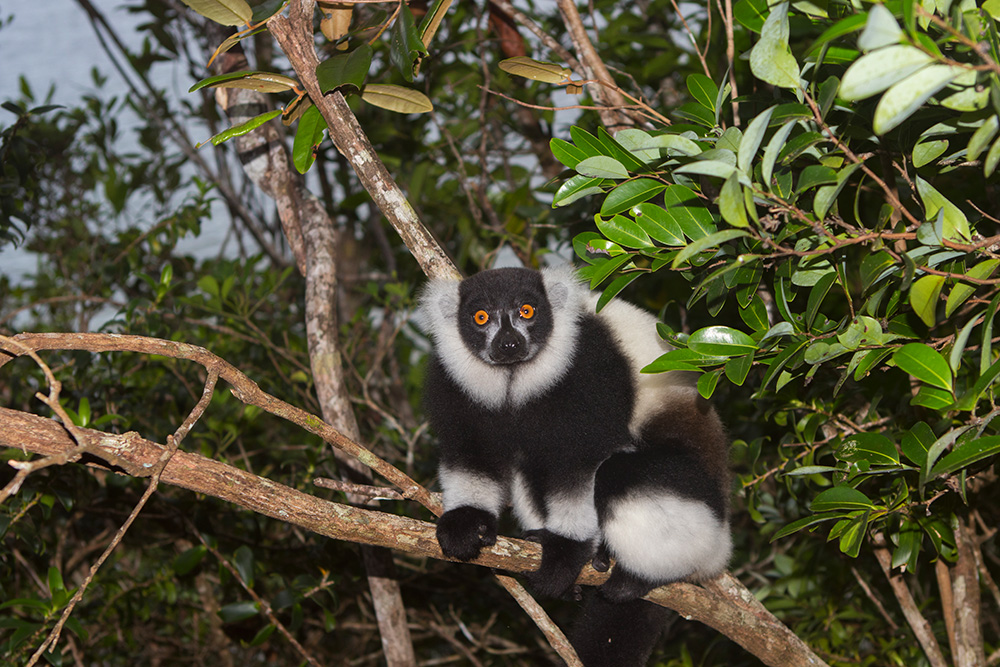
Nowadays, all left habitats are severely threatened by logging, mining and slash-and-burn agriculture. On the red list of threatened species, IUCN lists black-and-white ruffed lemurs as “critically endangered”. In the last almost 30 years, the population of this species has declined by more than 80%. Besides the largest threat for ruffed lemurs, the vanishing habitat, another problem is hunting: Their size, the loud calls and their curiosity makes them easy targets for hungry forest workers, poor people or poachers. Natural enemies such as the Fossa, mongooses or goshawks are mainly dangerous for young lemurs, they rarely catch an adult lemur.
Breeding outside Madagascar saves this species’ existence even if all left habitats on the red island would be destroyed. In 1997, captive-bred black-and-white ruffed lemurs were already released in Betampona reserve to stabilize the population there. Sadly, this action was not crowned with a lot of success. To save the black-and-white ruffed lemur, the original habitats have to be protected consequently. But like anything in Madagascar, implementing this goal needs a lot of time. For the ruffed lemurs, there is at least hope: Today, there is an estimated population of 10.000 black-and-white ruffed lemurs living on Madagascar, which could be the foundation of a stable population on a long-term base in the future.
 MADAMAGAZINE Your Magazine about Madagascar
MADAMAGAZINE Your Magazine about Madagascar
